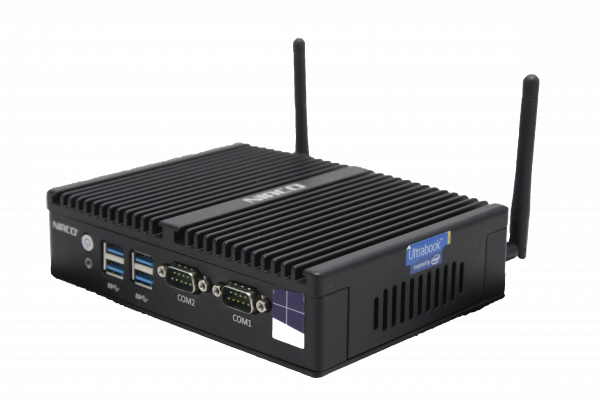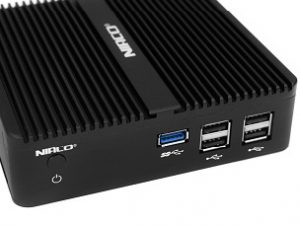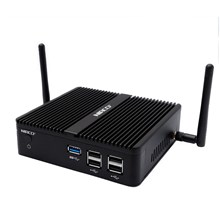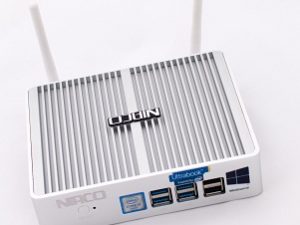Thin client
Small computers
Thin clients are computers with very small dimensions and good performance.
Thin client is a device with application software that uses its hardware resources to perform average tasks, and in case of lack of hardware resources, by installing special software, it can use new communication protocols (PCoIP VMware, RDP Microsoft, HDX Citrix) to provide the server hardware resources to the user and thus turn the thin client into a super computer.
Thin clients are equipped according to the needs of users and use special and generally weaker processors than mini PCs. In the standard types of thin clients, processors are used that have higher heat tolerance and can work without the need for a fan, which is a mechanical part, which increases the power consumption in the system and also increases the consumption in systems that need a fan. This is one of the factors of reducing organizational costs.
Also, due to the small body of the device, they use new ports called M-SATA and M2, which provide the ability to connect industrial SSD hard drives, which have no mechanical parts and have a very long life, which is another factor in reducing organizational costs. is . In terms of power consumption, thin client uses less than 30 W power supply due to the miniaturization of parts, which both helps the city power system and reduces the cost of UPS systems.

Apart from the cases mentioned above, a thin client can be a very suitable option for training workshops. Because this device occupies much less space and has high processing power. In addition, the use of thin client in educational workshops will be more affordable. Other cases where thin client can be used is the conference room.
The use of these systems in conference rooms and professors is very effective help to IT managers in setting up and supporting. With the help of a thin client with a remote, users can operate with only a mouse and keyboard, and it can be turned off and on by remote control.
It is better to know that less mechanical parts have been used in the production of mini PCs and thin clients compared to old computers, which has increased the productivity of these devices. Likewise, thin client is a good choice in classrooms.
Among other features of this device, it can be mentioned that it has a long life, as well as the durability and high quality of the parts. These devices can be used for a long time without breaking down. It is necessary to know that these devices also have high speed.
Fortunately, the use of thin clients and mini PCs has spread in academic spaces and educational centers, the most important reason for this is saving electricity and having small dimensions in a beautiful design, as well as their suitable facilities. Compared to old systems, this device is more cost-effective due to the reduced probability of failure and long life.

If we want to have a simple definition about thin client, we must say that it is a device with small dimensions and light weight, but with more power compared to normal cases. In order for a thin client to function properly, it is necessary to connect to the server; This has caused the performance of this device to have a direct relationship with the relevant server.
In fact, to put it more clearly, the way Thin Client works is that it first receives input commands through the mouse and keyboard connected to it through the USB port; Then it sends this information to the network server. After processing on the server, the desired information appears on the monitor.
How Nyako thin client works
The remarkable thing about the manufacturing and production of thin client and mini PC is that thanks to the advanced technology used in the design of these devices, they have been able to be an ideal replacement for heavy and expensive computers. In other words, with the introduction of thin client and small computer, we see the improvement of the performance of old computers. For example: the production of these devices in small dimensions has made it no longer necessary to allocate a lot of space to old and large cases; In this way, more space is available to users in office environments.
The main philosophy of producing a small computer or mini PC is to use the full features of a computer but in a small size. A mini PC in the form of a box has a CPU that can be added RAM and hard drive as needed. A switch or hub is needed to connect a thin client to the server. There are also several protocols for this communication; The most basic protocol is RDP, which is made by Microsoft and does not require any special software, and Windows supports it by default. By using thin client, you can benefit from all modern software such as: Photoshop, media player and office automation software.

In terms of the build quality of a thin client, we must say that all its parts are produced in the same factory, which guarantees their compatibility. One of the very important features of this product, as well as the small computer that distinguishes it from old systems, is its high speed. For example, the process of booting Windows in this device takes only 8 seconds! Also, its biggest advantage is long-term and 24-hour use without causing problems and disruptions in the device’s performance. Another advantage of this product is the ability to manage user performance. For example, you can limit the user’s access to the information or software you want and give him the possibility to use only a certain software.
Therefore, a client with features such as: high security, small and suitable dimensions, is an ideal choice for places with limited space, especially for office environments. In addition, you can easily upgrade the software you want. Also, a mini PC and client have lower energy consumption compared to old computers. As we said, the client needs to connect to the server to process information. The information is returned to this device after being processed by the server, and the client needs high bandwidth to transfer the information.
An important point for the correct operation and high speed of the device is the limited number of clients. Therefore, we recommend not to use the client for wide area networks (WAN); Unless a special tool is considered to limit the use of bandwidth in order to manage client traffic.
Important features of Nyako thin client
Thin clients are computers with very small dimensions and good performance.
Thin client is a device with application software that uses its hardware resources to perform average tasks, and in case of lack of hardware resources, by installing special software, it can use new communication protocols (PCoIP VMware, RDP Microsoft, HDX Citrix) to provide the server hardware resources to the user and thus turn the thin client into a super computer.
Thin clients are equipped according to the needs of users and use special processors that have higher heat tolerance compared to computers and can operate without the need for a fan, which is a mechanical part and increases the power consumption in the system. Also, the increase in depreciation in the systems that need a fan to work, which is one of the factors of reducing organizational costs.
Also, due to the small body of the device, they use new ports called M-SATA, which provides the ability to connect industrial SSD hard drives, which has no mechanical parts and has a very long life, which is another factor in reducing organizational costs. Also, the ability to add 2.5-inch hard drives is provided as a custom.
Due to the small size of the device, the small RAM memory of the laptop is used.
The communication part of this device in the network is by default Lan Card on the board, and if needed, the ability to add a wireless card to the device is provided.
In terms of power consumption, thin client uses a 30 watt power supply due to the miniaturization of the parts, which both helps the city power system and reduces the cost of UPS systems.
If we want to have a simple definition about thin client, we must say that it is a device with small dimensions and light weight, but with more power compared to normal cases. In order for a thin client to function properly, it is necessary to connect to the server; This has caused the performance of this device to have a direct relationship with the relevant server.
In fact, to put it more clearly, the way Thin Client works is that it first receives input commands through the mouse and keyboard connected to it through the USB port; Then it sends this information to the network server. After processing on the server, the desired information appears on the monitor.
How Nyako thin client works
The remarkable thing about the manufacturing and production of thin client and mini PC is that thanks to the advanced technology used in the design of these devices, they have been able to be an ideal replacement for heavy and expensive computers. In other words, with the introduction of thin client and small computer, we see the improvement of the performance of old computers. For example: the production of these devices in small dimensions has made it no longer necessary to allocate a lot of space to old and large cases; In this way, more space is available to users in office environments.
The main philosophy of producing a small computer or mini PC is to use the full features of a computer but in a small size. A mini PC in the form of a box has a CPU that can be added RAM and hard drive as needed. A switch or hub is needed to connect a thin client to the server. There are also several protocols for this communication; The most basic protocol is RDP, which is made by Microsoft and does not require any special software, and Windows supports it by default. By using thin client, you can benefit from all modern software such as: Photoshop, media player and office automation software.

The thin client has a weak processor and no hard disk. In fact, if you want to have a real computer, we suggest you get a mini computer or a small computer instead of buying a thin client. Therefore, thin client, like Xeroclient, acts only as an intermediary between the user and the server. In this way, with its help, hardware resources can be used. In general, thin client purchases are more common in office environments; The reason for this is that compared to a computer, it does not need to pay much.
Nyako thin client 35
Banks, educational centers and environments where it is necessary for the employees of different branches to have access to a single information, in most cases, they prefer to use thin client instead of preparing xero client or small computer. One of the important advantages of this type of computer is that compared to a mini computer, it does not require a lot of money; Because most of its performance is the responsibility of the desired server.
Regarding the amount of electricity consumption, we must say that although this amount is lower than that of a small computer, it has a higher electricity consumption compared to Xeroclient. Also, the durability and longevity of the thin client is longer than the mini computer; Because most of the activities and finally the processing pressure is on the server.
One thing we should mention is that when using the device, you will not be able to distinguish whether you are using a mini computer or a thin client. Of course, this type of computer does not have a space for storage, which makes it not a suitable option for different people according to the criteria they expect. But in general, a small computer has a lower price and a higher speed compared to a small computer.
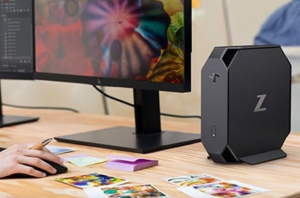
Today, due to the significant progress of technology, most people tend not to fall behind these changes and to benefit from new technologies by increasing their knowledge in this field. Buying a thin client and mini computer is one of the measures that can increase work efficiency and help different businesses with the help of new technology used in these devices. But maybe you also have this question, what is the difference between thin client and zero client? Are they different from mini computers? We have addressed this issue in this article. Stay with us.
In fact, a zero client is a computer connected to the network that cannot be used alone. If you want to use this device, you need to connect it to a network first. Then you can transfer the features you want to the computer through the network using XeroClient. This caused Xeroclient to have no space for storage; Only in order to establish a connection with the network, a firmware program is considered in it. The most important difference between Xeroclient and a small computer is that if you need space to store your personal information, Xeroclient is not a suitable option due to its lack of memory, and you need to use a minicomputer.
Thin client Nyako 325
In fact, XeroClient is only a hardware that can be used by connecting to the network. Also, you have to pay more for Xeroclient and for its maintenance and security compared to a mini computer. The size of Xeroclient is bigger compared to a small computer. One of the disadvantages of ZeroClient is that because this device is equipped with an output port, it is not possible to use two separate monitors! Also, as we said, the performance of this device depends on the server; Therefore, by disconnecting and reconnecting the network connection, we should see a decrease in speed and sometimes shutdown until it is connected to the network again.


